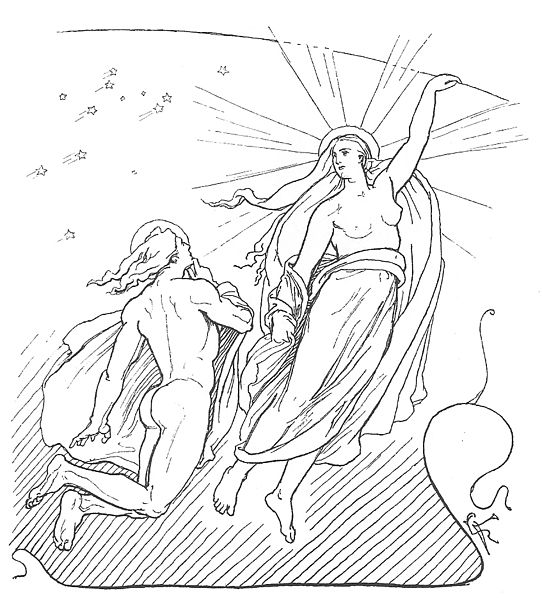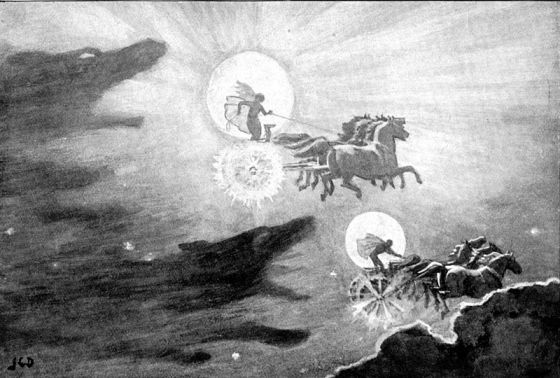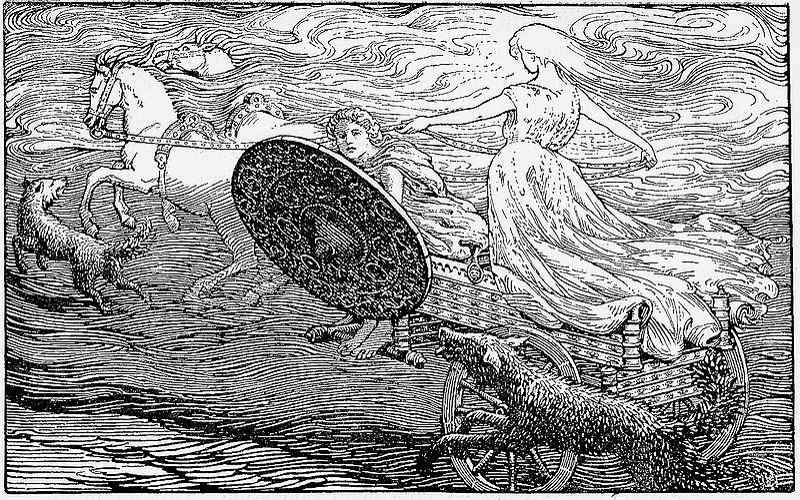In Norse mythology, there are four celestial beings associated with the night and day, sun and moon. Sól (Old Norse and modern Norwegian for sun) is the sun goddess. As the sun deity, her radiance touches both the gods and the mortals, illuminating their worlds and their tales. As a goddess the Vikings could see with their own eyes every day, she was obviously an oft mentioned goddess in everyday life.
Her significance in Norse cosmology is undeniable, and her journey across the sky is a testament to her enduring legacy. Like so many Old Norse stories, her story is one of both tragdey and death as well as triumphant rebirth.
Sól Key Facts
| Parents | Mundilfari |
| Partner | Glenr |
| Siblings | Máni |
| Offspring | Álfröðull (Elf Beam/Disc) |
| Tribe | Aesir |
| Old Norse Name | Sól |
| Other Names | Sunna |
| The Goddess of | Sun |
| Ass. Animal | Horses (Árvakr and Alsviðr) |
Name and Etymology
Sól, in Old Norse, translates directly to “Sun.” This direct association with the most vital celestial body underscores her importance among the Norse gods and goddesses. The name itself is evocative, conjuring images of bright, sunny days and the warmth that the sun brings. This is why some Norwrgian parents still choose this as their daughter’s name. Kennings, poetic metaphors used in Old Norse literature, often reference Sól when describing the sun, further cementing her place as the embodiment of daylight.
There’s evidence to suggest that the concept of a sun deity named Sól or a variant thereof might have existed in older Germanic or even Gothic mythologies. This continuity hints at the universal reverence for the sun and its deities across various cultures and epochs.
Sól’s Origins

Born to Mundilfari, Sól shares her celestial lineage with her brother, Máni, the moon god. Their intertwined destinies mirror the dance of the sun and the moon in the sky, a dance of light and shadow. While Sól represents the day, Máni governs the night, and together they maintain the balance of time in the Norse cosmos. Sól’s personal life also has its tales of love and legacy. She is partnered with Glenr, and together they are blessed with a daughter named Álfröðull, which translates to “Elf Beam” or “Elf Disc.”
The birth of Álfröðull adds another layer to Sól’s story. While Sól herself is the embodiment of the sun, her daughter’s name, reminiscent of radiant beams and discs, suggests a continuation of her luminous legacy. Moreover, it is as if the sun’s rays, in the form of Álfröðull, are a testament to Sól’s enduring presence.
Role and Depiction
In Norse mythology, Sól’s role is both luminous and essential. Every dawn, she embarks on her celestial journey, driving a chariot that is drawn by two magnificent horses, Árvakr (“Early Riser”) and Alsviðr (“Swift”). These horses, with their evocative names, are not just mere beasts of burden; they are vital components of the myth surrounding Sól. Their relentless run through the sky, pulling the sun behind them, symbolizes both the unstoppable march of time as well as the cyclical nature of life.

But Sól’s journey is not just about the radiant sun and her steadfast horses. Before her chariot, the shield Svalinn is held, acting as a protective barrier between the sun and the earth. Without Svalinn, the earth would be scorched by the sun’s fierce heat. The presence of this shield underscores the delicate balance that the gods maintain to ensure the world’s survival and harmony.
Moreover, her voyage is fraught with danger. The ever-present shadow of the wolf Hati, who chases her with the intent to devour, adds a layer of tension to her daily routine. This chase, a dance of light and shadow, embodies the eternal struggle between good and evil, hope and despair. However, through it all, Sól remains a beacon of hope, her light a symbol of resilience and endurance in the face of adversity.
Álfröðull taking her mothers’ Place
Eventually, as one of the signs that Ragnarök is near, Hati will catch up with Sól and devour her. This casts the world into darkness and Fimbulvetr, a three year long winter. In the aftermath of Ragnarök however, Álfröðull will take her mothers’ place, bringing the sun back.
Play Fun Norse Quiz
Is this article making you even more curious about Norse gods and goddesses? You can satisfy your curiosity by playing a fun Norse mythology quiz. This way, you can test your knowledge about Norse gods and goddesses, as well as fill in some gaps. Good luck and have fun playing!
Don’t forget to try our other games as well!
Compared to the greek god helios
There are many interesting similarities between the ancient Greek mythology and the relatively more “modern” Norse myths. To my non-scholar mind, they seem to be closely related, or moreover, that the latter “borrowed” many aspects of the first.
Both the Norse and the Greeks had their own take on the deities that governed the sun. Interestingly, while the Greeks saw the sun as a male god, Helios, the Norse had a goddess, Sól, lighting up their world. Helios, often shown with a shining crown, rode a chariot pulled by fiery horses across the sky. He was the guy who brought light and warmth to the world every day. On the other hand, Sól, whose name literally means “Sun” in Old Norse, was all about hope and resilience. Just like Helios, she had her daily ride across the sky in a chariot, but her journey was a bit more intense, with the ever-looming threat of the wolf Sköll chasing her.
Mentions in Ancient Texts

Poetic Edda
Völuspá
In the poem Völuspá, a deceased völva recounts the universe’s history and foretells the future to the disguised god Odin. She speaks of the early days:
“The sun from the south, the moon’s companion, her right hand cast about the heavenly horses. The sun knew not where she a dwelling had, the moon know not what power he possessed, the stars knew not where they had a station.” – Benjamin Thorpe translation
Vafþrúðnismál
Odin, in Vafþrúðnismál, questions the jötunn Vafþrúðnir about the sun and moon’s origins. Vafþrúðnir speaks of Mundilfari, the father of both Sól and Máni:
“Mundilfæri hight he, who the moon’s father is, and eke the sun’s; round heaven journey each day they must, to count years for men.”
In another stanza, Odin inquires about another sun post-Ragnarök, to which Vafþrúðnir mentions Sól’s daughter, who will tread her mother’s path after Ragnarök.
Grímnismál
In Grímnismál, Odin describes a shield named Svalinn placed before the Sun, preventing the earth from burning. He also mentions the wolves Sköll and Hati Hróðvitnisson, who pursue Máni and Sol respectively.
Alvíssmál
Thor, in Alvíssmál, questions the dwarf Alvíss about the Sun’s various names across different worlds. This leads to a list of names including “Dvalinn’s deluder” by the dwarves and “the lovely wheel” by the elves.
Prose Edda
Gylfaginning
In Gylfaginning, Sól is introduced as one of Mundilfari’s children. She is married to Glenr. The gods, angered by Mundilfari’s arrogance, place Sól and Máni in the heavens, making them drive the chariots of the sun and moon. Sól’s chariot is drawn by the horses Árvakr and Alsviðr. When asked about the sun’s rapid movement, High explains that Sól is pursued by the wolf Sköll, and her fate is to be caught by him eventually.
Skáldskaparmál
In Skáldskaparmál, various kennings and names for Sól are provided, including “daughter of Mundilfæri” and “fire of sky and air”. The horses Arvakr and Alsviðr are mentioned as drawing the sun. Sól’s significance is further emphasized through various mentions and kennings, highlighting her central role in Norse mythology.
Frequently Asked Questions
The wolf Hati pursues Sól in her journey across the sky.
Álfröðull, also known as Elf Beam or Elf Disc, is the daughter of Sól.
Yes, Dagr (Day) and Nótt (Night) represent day and night in Norse mythology.
Sól is foretold to be devoured by the wolf Hati during Ragnarok.
Odin, the Allfather, set the sun in motion.
Sól is considered to be of the Aesir tribe.
Featured Image Credit: W. G. Collingwood, Public domain, via Wikimedia Commons
